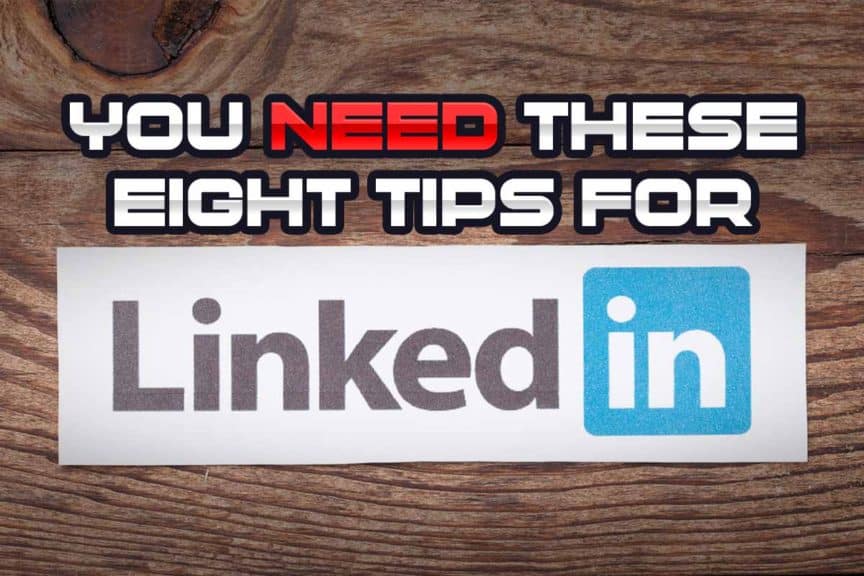If you’re a PT student or new PT graduate and you’re not using LinkedIn, you should be. It takes relatively little time to get an account going, and once it’s up and running you’ve basically got an online resume that doesn’t sleep or go on vacation. It’s an easy and effective way to begin building your reputation and letting the world know what you’re all about.
Whether you’re seeking employment or not, there are good reasons to get a LinkedIn profile going. And yes, you have plenty of great things you can put in your profile to begin standing out, even if you’re “only” a first-year PT student.
Article overview (Quick Links)
With LinkedIn being a free online professional networking platform for employment-oriented purposes, graduates who are serious about beginning to develop a reputation or presence within their field can help accelerate the process using LinkedIn.
Click/tap on any of the tip headlines below to instantly jump to that section of the article.
- Tip 1: Upload a professional photo to your profile
- Tip 2: Creating a custom URL to your profile
- Tip 3: Get your professional highlights going!
- Tip 4: Become regularly active on the platform for maximal success
- Tip 5: Keep your LinkedIn profile updated on a regular basis
- Tip 6: Get some recommendations & endorsements going!
- Tip 7: Select some “interests” for others to see
- Tip 8: Start following who and what you’re interested in
Tip 1: Upload a professional photo to your profile
This is a non-specific tip in regards to a profile as a PT, but it’s such a make-or-break factor that it’s worth mentioning right away, as I have seen plenty of PT student profiles with either no profile image or one that makes it hard to tell what the individual looks like.
So, the first step to take care of when you begin to make your profile pop and stand out a bit more is to upload a professional-looking photo. This would ideally be a headshot, as you want people to know who you are. Images of you that aren’t a headshot and are more of a full-body shot will be incredibly tough for others to identify you. With this, you need to keep in mind that many people who see your profile picture will only see a small image on their mobile device or computer screen.
Make sure the photo of you is well lit and that your face isn’t obscured by shadows or poor lighting conditions.
The good news is that with the camera technology coming out of phones these days, you can pull off a great looking headshot with your phone in a room or environment that is well lit.
Tip 2: Be sure to create a custom URL for your profile

Again, this is non-PT specific, but also another non-negotiable.
When you create you LinkedIn account, the URL that LinkedIn will use by default to take you to your profile page will contain all sorts of varied alpha-numeric text after the main linkedin URL. You’ll want to change this as it not only just looks terrible, but when networking with other PT’s or professionals within the field either in-person or online, it’ll be much easer for that individual to pull up your profile if they know that they just have to type your name after the LinkedIn URL.
As well, it also shows that you’re all the more serious about maintaining a professional presence online through taking your LinkedIn account a bit more seriously.
Tip 3: Get your professional highlights going!
The quick takeaway: Make sure your “about” section mentions your professional highlights (you have more experience than you think) as you need to let others know all about your work experience.
The “about” section is your chance to quickly show others not only who you are, but what you’re about, what you’re seeking, or opportunities you’re looking to leverage.
Make sure to grab the reader’s attention with some strong statements about yourself right off the bat. You want to give them more reason to keep on reading. Consider all of your PT-related experience thus far and think about how you’d word it to let readers know how passionate you are for what you do or what it is that you’re seeking.
You have more experience than you think!
PT students and even new grads sometimes don’t feel like they have enough experience to write a bio that can really stand out. But most actually do! If you’ve completed any or all of your clinical rotations, listing your student experience within these settings can be a great step to take.
Mentioning that you have completed a rotation in a specific type of setting or that you are interested in pursuing a specific designation can be great way to get the attention of other readers who come across your profile.
If you have’t completed any clinical rotations yet, mention your interests and ambitions for what you’re striving to achieve as a PT student who will one day be in clinical practice. You can also mention your volunteer hours that you collected when you completed the mandated requirements to applying to PT school (but I wouldn’t state that they were mandated requirements).
Stating that you have a couple hundred hours of clinical shadowing in a particular type of practice can be a great thing to mention if you have yet to start any student clinical rotations yet.
If you have relevant experience or training from your undergraduate studies, you could consider mentioning these as well. Mentioning that you have an undergraduate in Kinesiology or another related field can also help to stand out. Yes, you’ll list this later on in your profile under the “education” section, but it’s be worth mentioning in your “about” section in some capacity in order to grab the reader’s attention.
Tip 4: Becoming regularly active on the platform

If you want to get as much as you can out of LinkedIn, you need to make sure that you become (and stay) regularly active on the platform. This doesn’t mean you share photos of random pictures of you the way you might on other social media platforms.
Rather, as a PT graduate or PT student, you’ll want to share insights, blog posts and other informative resources on topics, issues or events pertaining to what YOU’RE interested in and find valuable. Chances are if you find some content online that you think is valuable and worth sharing, other professionals whom you network with will find value in it as well.
The content can be from other PT’s you follow, clinics or even organizations. When you’re actively posting PT-related content to a personal network that largely consists of other PT’s and healthcare professionals, you’ll provide helpful information to them while also indirectly staying on their radar.
Staying regularly active on the platform lets others know that you’re staying up to speed within your field
Aside from active posts being an indirect way of letting others know that you not only exist, they also show others how you’re staying up to speed on things while continually working to gain more experience, insight and even staying involved with organizations that are meaningful to you and your career.
If your posts or links that you’re routinely sharing help provide valuable information to others within your LinkedIn network (a lot of whom are likely to be in the same profession or realm of work), you will begin to stand out. What’s even better, you may even begin to establish authority on a particular topic or be seen as an expert that those other PT’s and professionals will then feel inclined to reach out to.
If you do this enough, other professionals will reach out to you on LinkedIn for a number of reasons. Not just for employment opportunities, but oftentimes for collaboration on projects, invitations for guest presentations or speaking, and so on. Your posts that are providing valuable insight, information or resources will be shared by others, furthering your reach and presence throughout the online world of PT professionals.
Tip 5: Keep your LinkedIn profile updated on a regular basis

In addition to staying regularly active with your posts, as a PT student or graduate you’ll want to keep your individual profile updated on a regular basis. This doesn’t mean that updates need to take place on a weekly or monthly basis. By “regular basis” for your own profile updates, I’m referring to making sure that you simply update your profile whenever there’s new “resume worthy” updates to share, such as certifications, awards, distinctions, etc.
Again, this is a way to indirectly show others that you’re taking your career and reputation seriously, which always looks good to others who come across your profile. PT’s have to take a certain number of CEU’s every year, which often come in the form of certifications or new credentialing. Make sure to update your profile whenever any of these new skills or credentials are obtained.
If your profile is always up to date, you can send it to someone the second they want to learn more about you
Lastly, an up-to-date profile is always important for when you meet a professional contact who wants to learn more about you. If you don’t have a resume or a business card on you, you can give them your LinkedIn URL (since you customized it, like I said in step 3, right?). And you can confidently give them your profile URL or tell them to search for you since you know that your profile is all up to date. No need to tell them you’ll send them the link, only as a means to create a stall-tactic in order to give you time to update everything.
The bottom line here: Keep everything about yourself, your current pursuits, credentials and experiences all up to date so that everyone knows your most current abilities, qualifications and so on.
Tip 6: Get some recommendations and endorsements going!
The quick takeaway: Get your recommendations & endorsements going by connecting with professors, your clinical instructors and other individuals within the PT-realm you’ve interacted with. Reach out and ask them!

By this point into either your schooling or your career, you likely have a lot of other smart and talented individuals within your field whom you know. If any of them are also on or using LinkedIn, you should consider reaching out to them and ask for a recommendation or endorsement on your profile.
Recommendations or endorsements on LinkedIn are exactly what they sound like – they’re other professionals within your network who vouch for your skills and abilities for what it is that you do. Nothing looks better than having other qualified professionals such as professors or former clinical instructors you personally know write statements on your profile as to why they recommend you or what makes you stand out from others in your field.
Don’t consider it awkward to ask other colleagues to ask for recommendations or endorsements
So, since you’ve spent the last few years of your life working hard to meet, interact and work with tons of talented and qualified professionals within your institution and clinics, reach out to them and ask for a recommendation or endorsement on your profile. Don’t consider asking to be awkward, so long as you have a good personal connection with them. These individuals won’t see it as peculiar, but rather as a sign that you are serious as to building your reputation as a PT.
Lastly, in addition to your endorsers being aware of how serious you are, having a bunch of recommendations and/or endorsements on your LinkedIn page from them is another great indirect way to show others that you’re serious about building a reputation for what it is that you do. It’s not about turning it into some sort of contest, rather it’s about having the desire to showcase your talents, be it for future employers to take notice or to simply let others know that you’re passionate about what you do!
Tip 7: Select some “interests” for others to see
The quick takeaway: Make sure to select some “interests” to let others know the type of information you like to follow, learn from and stay up to date with.
In the LinkedIn world, interests are companies, organizations, influencers, groups, and so on that you can follow right on the LinkedIn platform. Aside from you being able to stay current with any and all organizations, companies, etc. That you’re interested in, it’s also a great way for others looking at your profile to see what you’re into. This is a great way for them to see if you share similar interests, which could be beneficial for a number of reasons, such as deciding to reach out to you for collaboration, networking or … a job opportunity.
Tip 8: Start following who and what you’re interested in
The quick takeaway: Follow other PT’s, companies and professionals whom you look up to within the world of PT, injury rehabilitation and so on. Aim for at least 150 connections by the time you graduate or by the time you start your first job as a newly graduated PT.
Aiming for at least 150 connections within your network is a good target number to have as you begin to elevate your game on LinkedIn. No, it’s not a competition about who can get more people in their network. It’s about gathering up enough professionals within your network so that you’ll be staying on plenty of radars, and that those radars might pass your info on to someone else within their network.
Additionally, since you’ve got a strong looking & active profile, other people who come across your profile will be much more inclined to reach out to you and connect since your profile shows what you’re all about and what you’re capable of. This makes it easier to keep your connections number growing since many people will be interested in making a connection with you while you simultaneously seek to make connections with others.
Concluding remarks
Whether or not you’re actively seeking employment as a new PT graduate, upping your LinkedIn game is one of the first steps to take. As has been said many times before, your LinkedIn profile is a resume that never sleeps. Creating a professional looking and up-to-date profile should always be your first moves to make, whether looking for employment opportunities or not.
In addition to the potential for employment opportunities, a strong and active LinkedIn profile serves to help you foster new professional connections and networking opportunities that can lead to a great reputation within your field, chances for collaborations with other industry leaders and much more. Being seen as a new graduate (or student) who has enough passion for their field to actively share information and resources on the platform can catch the eyes of others within the field while showing them you’re all-in on staying up to speed in the industry as a PT.
Essentially, there’s really nothing to lose and a whole ton of amazing connections and opportunities to gain by creating and maintaining a strong and active LinkedIn profile. So, now that you’re done with this article, go either create your profile (if you don’t have one), or log into your current one and give it some love and updating. Your future professional self will thank you!

Hi! I’m Jim Wittstrom, PT, DPT, CSCS, Pn1.
I am a physical therapist who is passionate about all things pertaining to strength & conditioning, human movement, injury prevention and rehabilitation. I created StrengthResurgence.com in order to help others become stronger and healthier. I also love helping aspiring students and therapists fulfill their dreams of becoming successful in school and within their clinical PT practice. Thanks for checking out my site!

